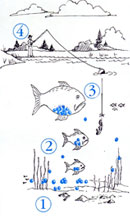Toxicology: Health Effects of Mercury Exposure
Elemental (metallic) mercury and all of its compounds are neurotoxic. It can also be absorbed through the lungs and skin and result in hypersensitivity reactions. Ingestion of inorganic mercury compounds can cause severe, potentially fatal damage to the kidneys, gastrointestinal tract and other organ systems and even very low levels of exposure can impair the immune system. Organic compounds of mercury such as methylmercury are considered the most toxic forms of the element. Exposures to very small amounts of these compounds in concentrated forms can result in devastating neurological damage and death.
For fetuses, infants and young children, the primary health effects of mercury are on neurological development. Even low levels of mercury exposure such those that result from the mother's intake of methylmercury from dietary sources such as fish can adversely affect the brain and nervous system impacting memory, attention, language and other skills. Dietary exposure to mercury has also been associated with cardiovascular, neurological and immunological impairments in adults.
Extensive information on the health effects of mercury is available from the Agency for Toxic Substances and Disease Registry (ATSDR) Mercury and Your Health website http://www.atsdr.cdc.gov/mercury/ .
How do people get exposed to mercury?
Airborne mercury is highly toxic when inhaled. How does it get in the air?
Like all liquids, metallic mercury slowly evaporates when exposed to the air. Mercury vapor levels in the air in an unventilated room can reach unhealthy levels just from the mercury released by broken thermometers or fluorescent light tubes.
Mercury is released into the outside air when coal, oil, or wood are burned as fuel or when mercury-containing wastes are incinerated and these releases are becoming a global public health issue. The mercury concentrations in outdoor air are that result from these combustion sources are usually low and of little direct concern. However, mercury in the air can fall to the ground with rain and snow, landing on soil or in bodies of water, causing contamination. Lakes and rivers are also contaminated by discharges of mercury-laden industrial or municipal wastewater.
When mercury enters bodies of water, biological processes transform it to methylmercury, a highly toxic and bioaccumulative form. Fish can absorb methylmercury from their food and directly from water as it passes over their gills.
The cycle of mercury in nature is complex. This illustration summarizes how methylmercury accumulates at the higher levels of the food chain and becomes concentrated in fish and animals that eat fish.

- Methylmercury in the water and sediment is taken up by tiny animals and plants known as plankton.
- Minnows and juvenile fish eat large quantities of plankton over time.
- Larger predatory fish consume many smaller fish, accumulating methylmercury in their tissues. The older and larger the fish, the greater the potential for high mercury levels in their bodies.
- Fish are caught and eaten by humans and animals, causing methylmercury to accumulate in human tissues.
Most people are exposed to mercury by eating fish containing mercury. There is no method of cooking or cleaning them that will reduce the amount of mercury in a meal.
From the mid-1950s to the 1970s, several mass poisonings took place in Japan and in Canada involving methylmercury from consumption of fish from contaminated waters. Although instances of poisoning from fish consumption in the U.S. have not been reported, the possibility of such poisoning has been a subject of concern. In the U.S., the number of states that have issued health advisories limiting consumption of fish has risen steadily from 27 states in 1993 to almost all of the states today. For additional information about the health impacts of mercury in fish refer to the EPA fish advisory website: http://www.epa.gov/hg/advisories.htm
Currently, concern is focused on the health impacts of chronic exposures to low levels of mercury from dietary sources. Preliminary estimates of mercury levels in hair and blood samples from the 1999 National Health and Nutrition Examination Survey suggest that approximately 10% of women have mercury levels within one tenth of potentially hazardous levels indicating a narrow margin of safety for some women. http://www.cdc.gov/mmwr/preview/mmwrhtml/mm5008a2.htm.  The National Research Council (NRC) issued a report estimating that as many as 60,000 newborns a year in the U.S. are now at risk for adverse neurodevelopmental effects from dietary mercury http://www.nap.edu/books/0309071402/html/
The National Research Council (NRC) issued a report estimating that as many as 60,000 newborns a year in the U.S. are now at risk for adverse neurodevelopmental effects from dietary mercury http://www.nap.edu/books/0309071402/html/  . These studies strongly support efforts to reduce methylmercury exposure.
. These studies strongly support efforts to reduce methylmercury exposure.
Additional Information Resources on Mercury in Fish
Seafood Information and Resources  - U.S. Food and Drug Administration's food information about the risks of methylmercury in fish and shellfish. You can also access this information toll-free at 1-888-SAFEFOOD.
- U.S. Food and Drug Administration's food information about the risks of methylmercury in fish and shellfish. You can also access this information toll-free at 1-888-SAFEFOOD.
Occupational Health Hazards in Biomedical Facilities
The most common potential mode of occupational exposure to mercury in biomedical facilities is probably via inhalation of vapors. If not cleaned up properly, spills of even small amounts of elemental mercury, such as may result from breakage of thermometers, can contaminate indoor air above recommended limits and lead to serious health consequences.
Some organic mercury compounds such as methylmercury, find limited direct use in biomedical research procedures such as gel electrophoresis and as a reference in nuclear magnetic spectroscopy. At least two fatal exposures have occurred in laboratories. The most recently reported incident involved a chemistry professor with an interest in the toxicology of heavy metals. During an experiment performed in a fume hood, she accidentally spilled several drops of methylmercury onto a gloved hand. The spill was considered inconsequential and cleaned up without special measures. Approximately two months later, the professor began to develop symptoms of neurotoxicity. She died despite receiving aggressive chelation therapy and medical support